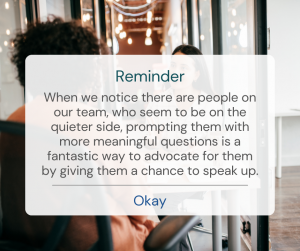Asking Questions To Help Others Speak Up
Have you ever asked a question and all you got in return was awkward silence? Or, you asked a question and the response was simply yes or no. There is such a thing to the art of asking questions, and in this article we will share strategies on how you can ask better questions to get others to open up and speak up.
1. Art of the Follow Up
When it comes to getting others to open up and share their thoughts, simply asking one question isn’t always sufficient. The key to mastering the art of asking great questions is in the skill of following up. It’s taking their first response, whether it’s a yes or no, and building upon it with further questions. Don’t assume once is enough.
Consider the following:
- Warm-Up – The first question we ask is often like a warm-up exercise. It’s like stretching before a workout – it gets the conversation going. Instead of simply asking, “Do you want to speak up?” we can take it a step further. We can follow up with a question like, “Why is speaking up important to you?” Asking “why” is like turning on a spotlight and saying, “Hey, tell me more!” It’s an invitation for the other person to dive deeper into their thoughts and share additional information.

- Share Their Thoughts –
Instead of simply asking, “Did you see the customer’s request?” we can qualify it by asking, “What did you think of what this customer said?” Asking for someone’s specific thoughts is key.
The more strategic and intentional we are with our follow-up questions, the better we can support and empower others to share their thoughts.
2. Context
Adding context to our questions can be helpful when engaging with someone who seems a bit closed off. It’s like giving them a roadmap to understand where we’re coming from and why we’re asking certain things.
Consider the following:
- Add Situational Context – When we add situational context to our questions, we give them a chance to reflect on the specific situation we’re referring to, which can lead to richer and more insightful responses.
Instead of asking a straightforward question like, “Why did you decide to go with this software system?” we can rephrase it to, “considering this software system has only been on the market for one year, I’m curious: what made you decide to go with this company?” By adding situational context, we’re giving others a clear reason why we’re curious about their choice.
By adding a touch of situational context, we’re not just asking a random question in isolation. We’re painting a picture of the circumstances surrounding their decision, allowing them to mentally revisit that moment and share their insights. However, be mindful of tone because if done without intentionality, it can come off as threatening.
3. Stretch Questions
When we stretch out our questions and provide a bit more space, it allows individuals to gather their thoughts and give a more thoughtful response. It’s like giving them an opportunity to consider their answers more deeply without rushing into a yes/no response.
Consider the following:
- Time To Think – When it comes to prompting others to share their ideas to give them the time to gather their thoughts and express themselves. Instead of firing off a quick question like, “What did you think of the meeting?” we can stretch out our question to provide context and give them that much-needed thinking time. For instance, we can say something like, “Last week’s meeting was really helpful because I finally understand why we are implementing this new software system. It made me realize how crucial it is for our team’s success. Now, I’m genuinely curious: What did you think about it?” By sharing our own insights first, we giving others more time to reflect before responding.

- Reference Point – Providing a reference point is really effective in stretching out questions and encouraging others to speak up. It also helps steer the conversation away from simple “yes” or “no” answers. Instead of asking a straightforward question like, “Did you understand how we are supposed to move forward with the project?” we can take a more engaging approach. For example, we can say something like, “I’m feeling a bit confused about what the specific deliverables are for this project. During the meeting, what key information did you take away about our deliverables?” By sharing our own confusion and seeking their perspective, we give others a clear focus.
When we stretch out our questions, we create a space for them to think and reflect, which often translates to a more thoughtful answer.
__
Whenever you’re ready, there are 3 ways we can help you:
- Discover your communications style so you know where to start. Over 4,000 people have found theirs here.
- Attend our monthly communication workshop to build communications confidence (new topics: public speaking, advocating for yourself, building credibility, etc) here.
- Get your brand in front of 43k+ people by sponsoring our newsletter or Soulcast Media | LIVE LinkedIn events [contact: hello@soulcastmedia.com]











